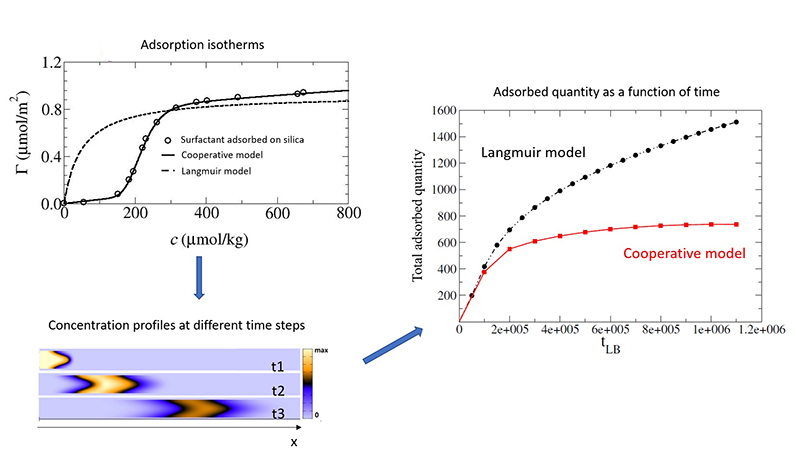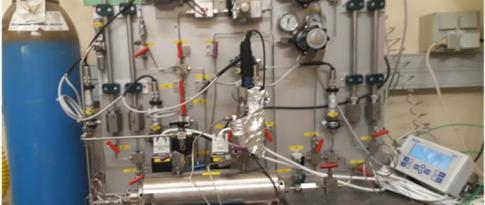Transport of molecules within porous structures that adsorb on the surfaces plays an important role in numerous contexts and very different applications. These include pollutant transport in soils, industrial catalytic conversion and purification processes, and chromatographic techniques. In all these situations, adsorption effects are known to strongly influence the circulation and transport of the fluids moving through confined geometries.
In view of this adsorption effect, particular attention must be paid to the behavior of complex molecules, such as surfactants, for example. These molecules are characterized by physico-chemical behavior at the fluid-solid interface that -most of the time - cannot be described using a classical adsorption model (for example the Langmuir model, which is a single-layer adsorption model). Often, since their behavior at the interface is characterized by aggregate formation, their adsorption may be dominated by cooperative effects and this interfacial behavior may have a specific and not insignificant influence on their transport properties. A better understanding of the transport of this type of molecule compared to conventional molecules is therefore necessary.
Within the context of PhD research* conducted in partnership with the CNRS and Grenoble University, we looked at adsorption kinetics and surfactant transport in combination via a generalized Lattice-Boltzmann approach, incorporating this adsorption effect [1]. To do so, we simulated the transport of molecules between two parallel planes, with adsorption isotherms from experimental data (anionic surfactant adsorbed on silica: see figure 1.a). The simulations were conducted on the basis of two different adsorption hypotheses in terms of thermodynamics: firstly, a conventional Langmuir model and, secondly, a surfactant adsorption model developed by us to include cooperative effects [2].
We showed that the total expected quantity adsorbed with the Langmuir model is far greater than that estimated by the new thermodynamic model, which accurately reproduces experimental data [3]. In addition, with the Langmuir model, this quantity increases more significantly over time (figure 1.b) due to its thermodynamics, which cannot correctly describe the specific interface behavior of complex molecules.

These results show that in transport models, obtaining physically coherent adsorption/transport behavior requires the development and inclusion of modeling specific to each type of adsorption, based on experimental data. This is particularly true for a better prediction of the transport of complex pollutants (nanoplastics, PFAS1, heavy metals, cosmetic products, etc.), the specific behavior of which in terms of adsorption must be taken into account by the modeling.
Future research will consist in examining transport and adsorption in combination in geometries that are representative of more complex structures, such as porous media. The challenge here relates to the heterogeneity of the porous medium, resulting in a specific velocity field, marked by significant disparities.
* Thesis by Zaineb Zaafouri: Modeling surfactant adsorption and transport in porous media: influence of adsorption thermodynamics and kinetics.
>> https://theses.hal.science/tel-03187740
References:
-
Z. Zaafouri, G. Batôt, C. Nieto-Draghi, B. Rotenberg, D. Bauer, B. Coasne, Lattice Boltzmann method for adsorption under stationary and transient conditions: Interplay between transport and adsorption kinetics in porous media, Physical Review E (2021)
>> https://doi.org/10.1103/PhysRevE.104.015314
-
Z. Zaafouri, D. Bauer, G. Batôt, C. Nieto-Draghi, B. Coasne, Cooperative Effects Dominating the Thermodynamics and Kinetics of Surfactant Adsorption in Porous Media: From Lateral Interactions to Surface Aggregation, Journal of Physical Chemistry B (2020)
>> https://doi.org/10.1021/acs.jpcb.0c08226
-
Z. Zaafouri, G. Batôt, C. Nieto-Draghi, B. Coasne, D. Bauer, Impact of adsorption kinetics on pollutant dispersion in water flowing in nanopores: A Lattice Boltzmann approach to stationary and transient conditions, Advances in Water Research, (2022)
>> https://doi.org/10.1016/j.advwatres.2022.104143
Scientific Contact: daniela.bauer@ifpen.fr
You may also be interested in
Adsorption, a key factor for geological storage
Low permeability geological layers, already known within the context of oil exploration, are once again becoming a focus of inter
Interactions between clay minerals and anionic surfactants
THESIS OF ARIANE SUZZONI
Interactions between clay minerals and anionic surfactants
THESIS OF ARIANE SUZZONI






